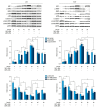Baicalin, a Chinese Herbal Medicine, Inhibits the Proliferation and Migration of Human Non-Small Cell Lung Carcinoma (NSCLC) Cells, A549 and H1299, by Activating the SIRT1/AMPK Signaling Pathway
- PMID: 29632297
- PMCID: PMC5909419
- DOI: 10.12659/msm.909627
Baicalin, a Chinese Herbal Medicine, Inhibits the Proliferation and Migration of Human Non-Small Cell Lung Carcinoma (NSCLC) Cells, A549 and H1299, by Activating the SIRT1/AMPK Signaling Pathway
Abstract
BACKGROUND Baicalin is a flavonoid derived from Scutellaria baicalensis, used in Chinese herbal medicine. Activation of the sirtuin 1 gene (SIRT1) and adenosine monophosphate (AMP)-activated protein kinase gene (AMPK), the SIRT1/AMPK signaling pathway, is associated with human malignant tumors. The aim of this study was to investigate the effects of baicalin on the cell viability, apoptosis, proliferation, and migration of human non-small cell lung cancer (NSCLC) cells, A549 and H1299, in vitro. MATERIAL AND METHODS Human NSCLC cells, A549 and H1299, were treated with serial doses of baicalin. Small interfering RNA (siRNA) silencing of the SIRT1 and AMPK genes was performed using cell transfection. The MTT assay was used to determine cell viability, flow cytometry was used to measure cell apoptosis, wound healing and transwell assays were used to assess cell migration of A549 and H1299 cells. Western blotting was used to measure protein expression and phosphorylation levels in untreated A549 and H1299 cells, and cells treated with increasing doses of baicalin. RESULTS Baicalin inhibited the viability, migration, and invasion of A549 and H1299 cells, and increased cell apoptosis in a dose-dependent manner. Baicalin activated the SIRT1/AMPK and mechanistic target of rapamycin (mTOR), and SIRT1/AMPK and matrix metalloproteinase (MMP) signaling in A549 and H1299 cells in a dose-dependent manner. siRNA silencing of SIRT1 and AMPK reduced the effects of baicalin on cell proliferation and migration. CONCLUSIONS Baicalin, a flavonoid used in Chinese herbal medicine, inhibited the proliferation and migration of human NSCLC cells, A549 and H1299, by activating the SIRT1/AMPK signaling pathway.
Figures




References
-
- Qian L, Ji AH, Zhang WJ, Zhao N. HuR, TTP, and miR-133b expression in NSCLC and their association with prognosis. Eur Rev Med Pharmacol Sci. 2018;22(2):430–42. - PubMed
-
- Jin MS, Hyun CL, Park IA, et al. SIRT1 induces tumor invasion by targeting epithelial mesenchymal transition-related pathway and is a prognostic marker in triple negative breast cancer. Tumor Biol. 2016;37:4743–53. - PubMed
-
- Kang YY, Sun FL, Zhang Y, Wang Z. SIRT1 acts as a potential tumor suppressor in oral squamous cell carcinoma. J Chinese Med Ass. 2017;78:1–7. - PubMed
MeSH terms
Substances
LinkOut - more resources
Full Text Sources
Medical
Miscellaneous

